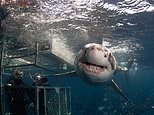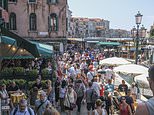
More than 80 per cent of the mammals and reptiles in Australia are unique to the country.
This makes it a bucket-list destination for animal lovers, with wildlife experiences on offer that range from cage diving with great white sharks to meeting Tasmania’s most famous resident – the Tasmanian devil.
Here we present the best wildlife tours to experience in Australia, many of which help to raise money to further the conservation of the country’s astonishing animal kingdom…
DIVE WITH GREAT WHITE SHARKS – SOUTH AUSTRALIA
In the 1960s, Adelaide man Rodney Fox survived a near-fatal great white shark attack that left him with 462 stitches in his chest, right hand and arm. But after recovering from the incident, rather than fearing these fascinating creatures, he decided to devote his life to researching them.
Rodney Fox Shark Expeditions sends travellers into the deep in shark cages off the coast of South Australia’s Neptune Islands. Image four shows Fox, who survived a great white shark attack in the 1960s
He established the Fox Shark Research Foundation, which identifies and catalogues great whites, as well as Rodney Fox Shark Expeditions, a tour operator that sends travellers into the deep in shark-diving cages off the coast of South Australia’s Neptune Islands.
Those brave enough to go diving with these apex predators have two cage types to choose from – the first is a ‘surface cage’ that sits at the waterline as great white sharks are seen ‘effortlessly gliding around and below the cage’.
Those who have a scuba diving license can go in an ocean floor cage, which descends approximately 20 metres (66ft) ‘into a world that will captivate and spell-bind – a blue aquarium of rocky outcrops teeming with reef fish, white sand and swaying sea-grasses’. The website notes: ‘The great white that appears out of the blue and sweeps gracefully towards, over and around the cage. It is amazing!’
Visit rodneyfox.com.au.
SEE THE OUTBACK WITH CAMELS – SOUTH AUSTRALIA
Camel Treks Australia offers a variety of camel-oriented excursions in the Gawler Ranges National Park
Camels were first introduced to Australia from the Canary Islands in 1840, the Australian tourist board reveals, with a population of more than one million camels now calling the continent home.
Allowing travellers to get to know these beautiful hump-backed mammals, Camel Treks Australia offers a variety of excursions with a caravan of camels, spread over several days, in the Gawler Ranges National Park of South Australia.
Guided by modern-day cameleers – people who lead camels through the outback – travellers can choose to either ride a camel through the desert terrain, or simply walk alongside them. The tour’s website notes: ‘Guest trekkers are often amazed by the depth of personality camels have. They can feel and respond to kindness and love, with some even seeking out people for such contact.’
Nights are spent camping in campsites equipped with private toilets and ‘deluxe’ tents with thick mattresses.
Visit cameltreksaustralia.com.au.
WHALE WATCHING – WESTERN AUSTRALIA
You might spot orcas (image three), long-finned pilot whales, sperm whales and dolphins cutting through the water near Bremer Bay in Western Australia
Each year, whales congregate in the waters above the Bremer Canyon, a 5,000m- (16,400ft) deep sea cleft that lies off the coast of the tiny town of Bremer Bay, southeast of Perth.
This makes it one of the world’s best whale-watching hotspots – you might spot orcas, long-finned pilot whales, sperm whales and dolphins cutting through the water on a wildlife-watching boat tour with Naturaliste Charters.
Expect to see researchers on board your boat, as the Naturaliste Charters team is involved with acoustic monitoring of whales and several environmental programs in the area.
In a recent review of the tour, Tripadvisor user ‘Lesley M’ described it as a ‘fantastic experience’, adding that it ‘felt like we were in a David Attenborough documentary’.
Visit naturalistecharters.com.au.
DIVE WITH WHALE SHARKS – WESTERN AUSTRALIA
Eco-tourism operator ‘Exmouth Dive and Whalesharks Ningaloo’ takes travellers around the Ningaloo Marine Park so they can swim with whale sharks and other sea creatures
The Ningaloo Marine Park – which lies halfway up Western Australia’s coastline – is one of the world’s longest fringing (close to shore) reefs, stretching an incredible 240km (149 miles). And it spans 2,435 sq km (940 sq miles).
The World Heritage Listed site is ‘home to deep under-sea canyons, diverse colourful sponge gardens and rich fish communities’, the country’s national parks site notes.
Eco-tourism operator ‘Exmouth Dive and Whalesharks Ningaloo’ takes travellers around the marine park’s waters so they can swim, snorkel or scuba-dive with Ningaloo’s underwater residents – which notably includes whale sharks, the world’s largest fish, known to stretch up to 15m (49ft) in length.
Other sea creatures you might spot include dolphins, manta rays, turtles, and humpback whales. These tours also double as a data-collection exercise, with the team contributing to environmental studies and scientific research to ensure the longevity of the reef.
Visit exmouthdiving.com.au.
THE WILDLIFE WONDERS TOUR – VICTORIA
Spot koalas (image one) and bandicoots (image two) – along with ‘many other amazing Australian animals’ at the Wildlife Wonders refuge
The Wildlife Wonders animal sanctuary offers guided tours with a conservationist through the magical Otways bushland, which surrounds its location near the coastal town of Apollo Bay, on the renowned Great Ocean Road driving route.
As you walk, you’ll learn ‘the secrets of the bush and the plants and animals’ in the region, the refuge’s website says. It adds: ‘It’s almost certain you will see koalas, but you might also be lucky enough to spot a potoroo, bandicoot [ both marsupials] and many other amazing Australian animals that call Wildlife Wonders home.’
Wildlife isn’t the only lure – the tour takes in some epic scenery too, revealing eucalypt woodlands and spectacular ocean vistas. What’s more, you give back with your visit – 100 per cent of the profits generated go to support conservation efforts to protect Australia’s threatened species.
Visit wildlifewonders.org.au.
MEET TASMANIAN DEVILS – TASMANIA
See Tasmanian devils (above) at the Devils At Cradle sanctuary in Tasmania
For some, a trip to Tasmania might feel incomplete without sighting the state’s most famous resident – the Tasmanian devil.
Get acquainted with the marsupial at the Devils At Cradle sanctuary, a breeding and conservation facility on the edge of the Cradle Mountain National Park World Heritage area that works to ensure the survival of healthy numbers of Tasmanian devils in the wild.
With tours available day or night, visitors can observe these curious creatures up close, learning about their life cycles and the threats they face with talks from the refuge’s expert team. Tasmanian devils aren’t the only marsupials the sanctuary protects – there are also spotted-tail quoll and eastern quoll to be encountered.
Visit devilsatcradle.com.
HAVE BREAKFAST WITH A KOALA – QUEENSLAND
Visitors can sit down for a ‘gourmet’ breakfast spread in the koala habitat within the Currumbin Wildlife Sanctuary
This experience makes breakfast the most exciting meal of the day.
Currumbin Wildlife Sanctuary in the Queensland city of Currumbin offers visitors the chance to have breakfast with koalas, sitting down for a ‘gourmet’ spread in the refuge’s ‘Koala Habitat’.
During the meal, visitors can chat with the koala keepers, ‘enjoy a koala cuddle’ and get their photograph taken with the creatures. Once breakfast has wrapped, they can set off to explore the rest of the sanctuary, home to 27 hectares of Currumbin rainforest and animals such as kangaroos, echidnas (a spiky mammal) and possums.
The sanctuary’s Currumbin Wildlife Hospital is one of the busiest wildlife hospitals in the world, treating more than 140,000 creatures over the past 20 years. All the money you spend goes to conservation projects, making sure more animals can be cared for in years to come.
Visit currumbinsanctuary.com.au.
VISIT A WILDLIFE REFUGE – NORTHERN TERRITORY
The Kangaroo Sanctuary Wildlife refuge is on a mission to educate and encourage people to rescue and care for kangaroos and other wildlife
The Kangaroo Sanctuary Wildlife refuge for rescued orphaned baby kangaroos and adult kangaroos lies near the outback town of Alice Springs.
It runs guided tours in the late afternoon each day, just when their kangaroos are starting to wake from their daytime sleep. The sanctuary’s website notes: ‘Our Kangaroo Sanctuary is a place to celebrate the beauty of the red kangaroo – an Australian icon… our mission is to educate and encourage people to rescue and care for kangaroos and other wildlife.’
The refuge has something of a cult following – a TV docuseries, Kangaroo Dundee, was made about the kangaroos it cares for, with the show airing in over 90 countries worldwide.
Visit kangaroosanctuary.com.
SPOT KANGAROOS BY THE SEA – NEW SOUTH WALES
You might spy kangaroos as you tackle the short hiking trail at the Look At Me Now Headland in the Moonee Beach Nature Reserve (above)
Blend seeing stunning scenery with wildlife spotting in New South Wales, where a number of beaches and bays are prime locations for kangaroo sightings.
Keep an eye out for eastern grey kangaroos at beautiful Diamond Head Beach in Crowdy Bay National Park on the Barrington Coast, a three-and-a-half-hour drive north of Sydney.
You might spy more wild kangaroos as you tackle the short hiking trail at the Look At Me Now Headland in the Moonee Beach Nature Reserve. ‘All year round, you can see eastern grey kangaroos nibbling on the grass,’ the national parks website notes.
And whilst you’re paddling in the waters of Depot Beach and Pebbly Beach in Murramarang National Park, north of Sydney, look to the grassy clearings around the shore – kangaroos are often seen hopping along nearby.
CROCODILE SPOTTING – QUEENSLAND
Travellers can see crocodiles getting fed as they cruise around the lagoons at Hartley’s Crocodile Adventures
Dating back to the 1930s, Hartley’s Crocodile Adventures has long been an institution for tourists in far North Queensland.
The first place in Australia to breed crocodiles in captivity, the focus at the wildlife centre is on crocodile conservation. Its website notes: ‘Documentaries produced at Hartley’s helped arouse public interest and sympathy for crocodile conservation, leading to the protection of wild crocodiles in 1974.’
Travellers can see crocodiles getting fed as they take a boat ride around the centre’s croc-filled lagoons, with expert guides sharing facts about the lives of these fascinating reptiles throughout the tour. ‘Getting up close and personal with these impressive creatures was amazing,’ declared Tripadvisor user ‘LeisuremanVic’.
Crocodiles aren’t the only creatures at the centre – there are also snakes, cassowaries (a large bird), lizards and kangaroos.
Visit crocodileadventures.com.
Source link
CHECK OUT: Top Travel Destinations
READ MORE: Travel News



